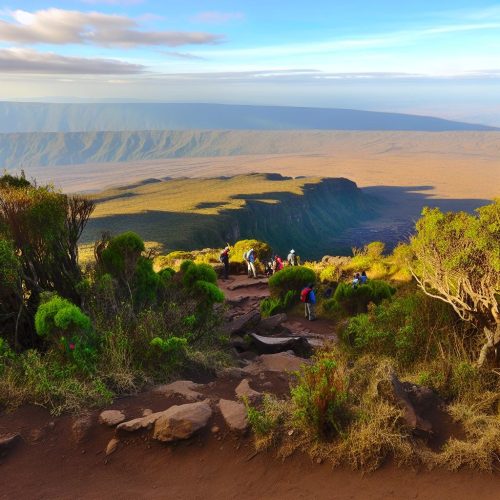The Menengai Crater
The Menengai Crater, a stunning geological phenomenon, is located in Kenya, approximately 10 kilometers north of Nakuru town. This extensive caldera offers breathtaking views and is of significant geological interest. Recognized as one of the most intact examples of a collapsed volcano on the African continent, Menengai Crater stands out due to its impressive scale and unique features.
Formation and Geology
Around 8,000 years ago, the Menengai Crater materialized as a consequence of volcanic activity, marking a pivotal moment in the region’s geological history. Rising approximately 2,490 meters above sea level, this crater is second only to a few others globally in terms of size and preservation. Spanning roughly 12 kilometers in diameter and plunging about 500 meters deep, it offers a captivating glimpse into the intricate processes that shape our planet.
Menengai’s geological make-up primarily consists of trachytic lava, which covers much of the crater floor. Although somewhat barren, the surface showcases an assemblage of solidified lava flows intermingled with steaming hot springs. This combination provides a unique opportunity for geologists and enthusiasts alike to study the dynamic interaction of volcanic activity and geothermal energy. These features pose critical questions about earth’s geothermal processes, making Menengai a valuable site for scientific research.
Hiking Experience
A visit to the Menengai Crater offers adventurers and geology enthusiasts a rare opportunity to explore a natural marvel on foot. The trails crisscrossing the crater are suitable for a wide spectrum of fitness levels, ensuring that both beginners and seasoned hikers can enjoy the experience.
The primary hiking trail sets off near the Menengai Forest cover, guiding adventurers to vantage points with sweeping views over the Great Rift Valley. The journey to the crater’s summit is fairly straightforward, typically requiring 3 to 4 hours, depending on the hiker’s speed and stamina. On reaching the rim, visitors are treated to a magnificent vista that encompasses the caldera and its remarkable surroundings.
Guides and Safety
Though one can hike the Menengai Crater independently, enlisting the help of a local guide can substantially enrich the experience. Guides offer insightful narratives about the area’s rich history, its geological importance, and the compelling folklore interwoven with the crater’s identity. For safety, it is prudent to don sturdy hiking boots, carry an ample supply of water, and embark on hikes early to minimize the impact of the midday heat.
Flora and Fauna
Despite its seemingly stark appearance, the Menengai Crater supports a surprisingly diverse array of flora and fauna. The landscape is dotted with acacia trees, colorful wildflowers, and indigenous shrubs, painting a picturesque scene against the rugged terrain. Birding enthusiasts can revel in the presence of various avian species such as hawks and sunbirds, which thrive in this unique environment. Occasionally, larger mammals like baboons and vervet monkeys make an appearance, particularly near the forested patches within the crater.
Accessibility and Accommodation
The Menengai Crater is relatively accessible thanks to its proximity to Nakuru town, a hub that offers various amenities and services. Numerous tour operators in Nakuru provide guided expeditions to the crater, handling transportation logistics to ensure a seamless experience for visitors. For overnight stays, Nakuru town boasts a mix of accommodation options ranging from budget-friendly hostels to more luxurious hotel establishments, catering to diverse preferences and budgets.
Environmental and Cultural Significance
Beyond its awe-inspiring natural attributes, the Menengai Crater is steeped in cultural significance for the native communities. Revered by local tribes as a sacred site, the crater is enveloped in numerous myths and legends passed down through generations. These narratives add a layer of cultural richness to the natural allure of the place, making it a fascinating subject for those interested in the interplay between nature and culture.
Efforts are underway to conserve the crater’s natural and cultural heritage, aligning with initiatives to foster sustainable tourism practices. These endeavors are crucial to preserving the area’s integrity while allowing visitors to appreciate its wonders responsibly.
For travelers keen on delving deeper into Menengai’s geothermal dynamics or exploring other attractions within Kenya, it is advisable to consult reputable travel resources or close-knit tourism boards for comprehensive guides and insights. The Menengai Crater offers a unique blend of adventure, scientific intrigue, and cultural depth, appealing to a broad audience of explorers eager to uncover the hidden treasures of this remarkable site.
